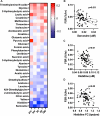Metabolomic response to acute resistance exercise in healthy older adults by 1H-NMR
- PMID: 38547208
- PMCID: PMC10977811
- DOI: 10.1371/journal.pone.0301037
Metabolomic response to acute resistance exercise in healthy older adults by 1H-NMR
Abstract
Background: The favorable health-promoting adaptations to exercise result from cumulative responses to individual bouts of physical activity. Older adults often exhibit anabolic resistance; a phenomenon whereby the anabolic responses to exercise and nutrition are attenuated in skeletal muscle. The mechanisms contributing to age-related anabolic resistance are emerging, but our understanding of how chronological age influences responsiveness to exercise is incomplete. The objective was to determine the effects of healthy aging on peripheral blood metabolomic response to a single bout of resistance exercise and whether any metabolites in circulation are predictive of anabolic response in skeletal muscle.
Methods: Thirty young (20-35 years) and 49 older (65-85 years) men and women were studied in a cross-sectional manner. Participants completed a single bout of resistance exercise consisting of eight sets of 10 repetitions of unilateral knee extension at 70% of one-repetition maximum. Blood samples were collected before exercise, immediately post exercise, and 30-, 90-, and 180-minutes into recovery. Proton nuclear magnetic resonance spectroscopy was used to profile circulating metabolites at all timepoints. Serial muscle biopsies were collected for measuring muscle protein synthesis rates.
Results: Our analysis revealed that one bout of resistance exercise elicits significant changes in 26 of 33 measured plasma metabolites, reflecting alterations in several biological processes. Furthermore, 12 metabolites demonstrated significant interactions between exercise and age, including organic acids, amino acids, ketones, and keto-acids, which exhibited distinct responses to exercise in young and older adults. Pre-exercise histidine and sarcosine were negatively associated with muscle protein synthesis, as was the pre/post-exercise fold change in plasma histidine.
Conclusions: This study demonstrates that while many exercise-responsive metabolites change similarly in young and older adults, several demonstrate age-dependent changes even in the absence of evidence of sarcopenia or frailty.
Trial registration: Clinical trial registry: ClinicalTrials.gov NCT03350906.
Copyright: © 2024 Moosavi et al. This is an open access article distributed under the terms of the Creative Commons Attribution License, which permits unrestricted use, distribution, and reproduction in any medium, provided the original author and source are credited.
Conflict of interest statement
The authors have declared that no competing interests exist.
Figures




References
-
- Fujita S, Rasmussen BB, Cadenas JG, Drummond MJ, Glynn EL, Sattler FR, et al.. Aerobic exercise overcomes the age-related insulin resistance of muscle protein metabolism by improving endothelial function and Akt/mammalian target of rapamycin signaling. Diabetes. 2007. Jun;56(6):1615–22. doi: 10.2337/db06-1566 - DOI - PMC - PubMed
Publication types
MeSH terms
Substances
Associated data
Grants and funding
LinkOut - more resources
Full Text Sources
Medical

